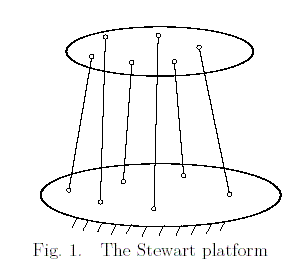Xiao-Shan Gao and Deli Lei
The Stewart platform, originated from the mechanism designed by Stewart for flight
simulation [18], is a parallel manipulator consisting of two rigid bodies: a moving platform,
or simply a platform, and a base (Figure 1). The position and orientation (pose) of the
base are fixed. The base and platform are connected with six extensible legs via spherical
or revolute joints. For a set of given values for the lengths of the six legs, the position
and orientation of the platform could generally be determined. The Stewart platform is in a
central status in the literature on parallel manipulators in the past twenty years and has been
applied to various fields such as robotics, numerically controlled machine, nano-technology,
etc. Comparing to serial mechanisms, the main advantages of the Stewart platform are its
inherent stiffness and high load/weight ratio. For a recent survey, please consult [4].
Many variants of the Stewart platform were introduced for different purposes. Most of
these variants are special forms of the Stewart platform in Figure 1. In [6], Faugere and
Lazard gave a classifcation of all special forms of the Stewart platform. An exception is
[3], in which Dafaoui et al introduced a new kind of Stewart platform which is based on
distances between points on the base and planes on the platform. In [1], Baron et al studied
all the possibilities of using three possible joints, the revolute joint, the spherical joint and
the prismatic joint, to connect the legs and the platforms. Another modification is to add
extra sensors to the Stewart platform in order to find a unique position of the platform or
to do calibration. Some recent work on this aspect could be found in [2, 22].
Generalized Stewart Platforms and their Direct Kinematics
Xiao-Shan Gao and Deli Lei
Key Laboratory of Mathematics Mechanization
Institute of Systems Science, AMSS
Academia Sinica, Beijing 100080, China
xgao@mmrc.iss.ac.cn
Qizheng Liao
School of Automation, Beijing University of Posts and Telecommunications
Beijing 100876, China
Gui-Fang Zhang
Department of Computer Science and Technology, Tsinghua University
Beijing 100080, China
You can download the entire thesis:
http://www.mmrc.iss.ac.cn/~xgao/paper/05-ieeetro.pdf

In this paper, we will introduce the generalized Stewart platform, which could be consid-
ered as the most general form of parallel manipulators with six DOFs in certain sense. By
a distance constraint, we mean to assign a distance value between two points, a point and
a line, a point and a plane, or two lines. By an angular constraint, we mean to assign an
angular value between two lines, a line and a plane, or two planes. A generalized Stewart
platform (abbr. GSP) consists of two rigid bodies connected with six distance or/and an-
gular constraints between six pairs of points, lines and/or planes in the base and platform
respectively. Since a rigid body in space has six DOFs, the GSP consists of all possible ways
to determine the pose of one rigid body based on another one.
We prove that there exist 3850 possible forms of GSPs. The original Stewart platform
in Figure 1 is one of them, in which all the six constraints are distance constraints between
points. The Stewart platform introduced in [3] is similar to one of them, in which all
the six constraints are distance constraints between points in the base and planes in the
platform. We show that by using different combinations of revolute, prismatic, cylindrical,
spherical, and planar joints, all these GSPs can be realized as real mechanisms. The purpose
of introducing these new GSPs is to find new and more practical parallel mechanisms for
various purposes.
A large portion of the work on Stewart platform is focused on the direct kinematics: for
a given position of the base and a set of lengthes of the legs, determine the pose of the
platform. This problem is still not solved completely until now. For the original Stewart
platform, Lazard proved that the number of complex solutions of the direct kinematics is
at most forty or infinite for the case that the base and platforms are planar[11]. The same
bound in the spatial case was proved by Raghavan [16], Ronga and Vust [17], Lazard [12]
and Mourrain [14, 15] with different methods. Dietmair showed that the Stewart platform
could have forty real solutions [5]. On the other hand, Wen-Liang and Zhang-Song gave the
analytical solutions for the Stewart platform with planar base and platforms [19, 21]. For the
general case, Husty derived a set of six polynomial equations which may lead to an equation
of degree forty [10].
In this paper, we give the upper bounds for the number of solutions of the direct kine-
matics for all 3850 GSPs by borrowing techniques from Lazard [12] and Mourrain [14, 15].
One interesting fact is that the direct kinematics for many GPSs are much easier than that
of the Stewart platform. We identify a class of 35 GPSs whose upper bound of solutions
is half of the original Stewart platform. We also show that for a class of 1220 GSPs, we
could find their analytical solutions. From these solutions, we may obtain the best maximal
numbers of real solutions for this class of GSPs.
One specific reason leads us to introduce the GSP is that the direct kinematic problem
for the original Stewart platform is considered a very diącult task [4]. While for some of
the GSPs, the direct kinematic problem is much easier. The difficulty in solving the direct
kinematic problem is considered to be a major obstacle of using the Stewart platform in
many applications. These new GSPs might provide new parallel manipulators which have
the stiffness and lightness of the Stewart platform and with an easy to solve direct kinematic
problem.